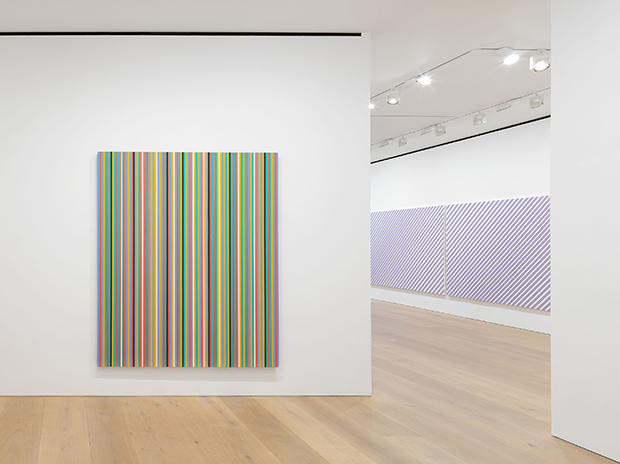
Bridget Riley by the man who knows her best
Phaidon author Richard Shiff walks you round a fantastic David Zwirner show of her Stripe Paintings
As well as being one of the main contributors to our very well received and thoroughly excellent book on the abstract painter Robert Mangold, Richard Shiff is also a well renowned expert on the work of, and a close friend to the British painter, Bridget Riley. He took Phaidon.com around The Stripe Paintings 1961-2014 (on until July 25) at David Zwirner, London a week or so back so we thought we would share with you some of the things he pointed out in Riley's work.
Richard began explaining how Riley will change a stripe a number of times - on one occasion even after the initial round of photography was completed. "It's not unlike her to settle on one area of a painting and rework it again and again, testing out colours next to each other. She's very precise." He pointed out that Riley is "very insistent that she doesn't use a system, rather a format. It's worked out very gradually, very empirically from beginning to end and she makes adjustments as she goes along," he added.
As Phaidon's The Art Book points out in its commentary on Riley's Cataract 3 painting: Its connection with the Op Art movement is apparent in the interplay of colour and lines which produces a stunning, shimmering optical illusion. It was this interplay and illusion in Riley's work that Shiff returned to again and again as he walked us round the gallery.
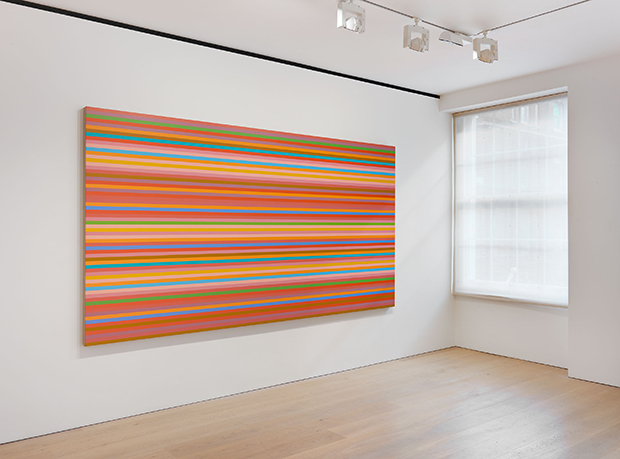
Pausing to stop in front of a handful of the 20 paintings on show at Zwirner, he explained how "often it's a colour change that you're not sure is happening or "some kind of dimensional shift" which leads to the commonly reported effect that some of the paintings feel as if they're "coming towards you then, the next minute, going away - an optical effect The Art Book calls "exploring and exploiting the fallibility of the eye."
"There are these optical effects that are just on the edge of you being able to understand them and you can't quite," Shiff said. "And quite is a word that she sometimes uses herself." As he progressed from room to room, painting to painting, Shiff voiced the realisation "that there are more colours optically than there are physically," and that "the paintings are always giving you more than what is there.
"Violet colour surrounds either red or green and the red or the green then surrounds the narrow white and that will cause that white to appear something other than white," he said. "It will become pinkish or greenish and that makes the other bands of white look much more white. There are phantom colours that appear in addition."
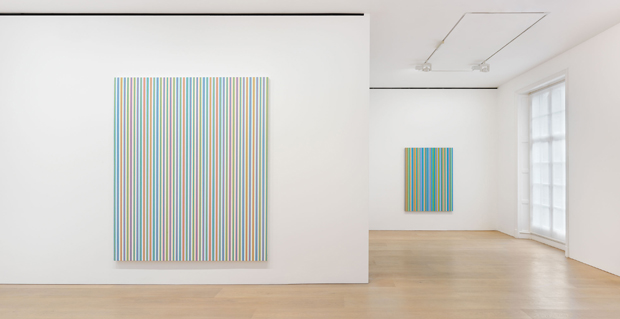
Shiff was particularly revelatory on the process behind Riley's work when it came to her Egyptian-influenced group of paintings from the early 1980s. "I think it's five colours plus black and white and they're based on colours she observed in the ancient wall paintings in Egypt," Shiff said. "She was interested in creating certain rhythms across these vertically oriented stripes that are varied and irregular but distinct. And again, as I try to describe what I'm seeing I know I'm seeing it but finding the words for it is not easy. Again, she's right on the edge of one thing and another thing.
"In her terms, what makes these paintings work is that the blacks and the whites being at opposite ends of the greyscale and thoroughly neutral chromatically, establish a kind of beat or stabilisation," Shiff said. "And those stripes are narrower than the chromatic stripes because that amount of neutral colour is sufficient. And then the chromatic stripes are sometimes dramatically opposing like the turquoise and the reddish orange colour and sometimes the combinations repeat."
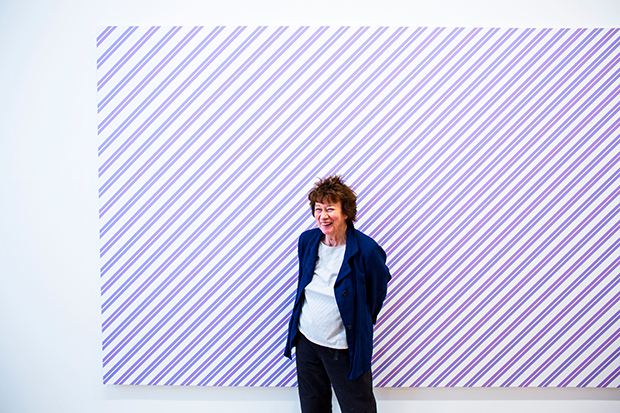
"One of the things Bridget Riley has, more than any artist, is that she has the capacity to make optical effects that are thoroughly dematerialised or immaterial. We become very conscious of them and we can't really pin them down to the material paint that she's using. There's another dimension that extends out of these pairings and we have the sense of something rising and or projecting outward."
Riley's own appreciation of art history is borne out by her glowing review of Phaidon's legendary book, The Story of Art by EH Gombrich which she described as "the first history of art I read as a 19-year-old student" calling it "a revelation" and a book that "pushed open the door on some of the greatest achievements of the human spirit."
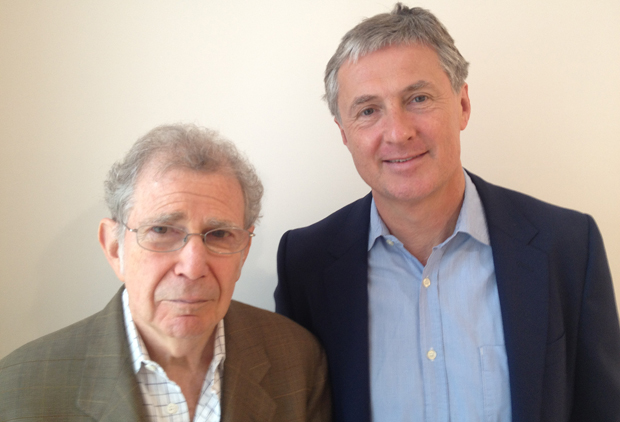
But what's often overlooked or underreported about her work is the influence that huge names such like Cézanne, Renoir and Monet have had on it. As Shiff noted: "If you just walked in off the street in to the gallery and you didn't know who Bridget Riley was you'd assume the last thing she'd be looking at would be Renoir or Monet," Shiff said. "But she's always looked at art from her artist eye and not had any ideological baggage to go with it. If you take a square inch of a Cézanne you'll find all of those colours because he's mixing all of them on the brush and looking for some kind of atmospheric quality overall. Impressionist artists were painting the daylight, they very interested in atmospheric effects, Cézanne liked to work outdoors. And Bridget Riley makes abstract art with a very similar interest.
"It's a way of intensifying the effect that she's really interested in without having to be concerned whether the colour is in someone's skin, or in the tree outside the studio. Among the modern masters she often refers to Mondrian. But I think in Mondrian's case what impressed her was his dedication - the fact that he, like her, was in the studio all the time, always working and pushing himself."
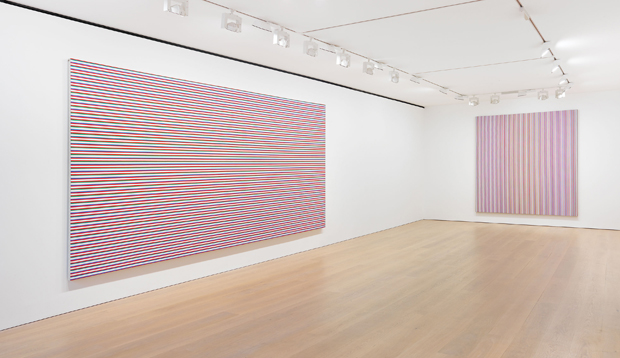
Shiff finished up by paying tribute to Riley's sheer force of will. "In her case she was free to become an abstract artist. But maybe if there hadn't been abstract artists before her she would have invented that because she was independent enough to do that. She liked Ad Reinhardt and Barnett Newman - artists that extended their visual reach as far as they could within the limitations their culture imposed on them.
If you've enjoyed Richard Shiff's thoughts on Bridget Riley you really should check out his Robert Mangold book. And if you'd like to learn art history as Bridget Riley learnt it, then buy a copy of of The Story of Art the best-selling title beloved by Riley and many other artists who have changed our world for the better.